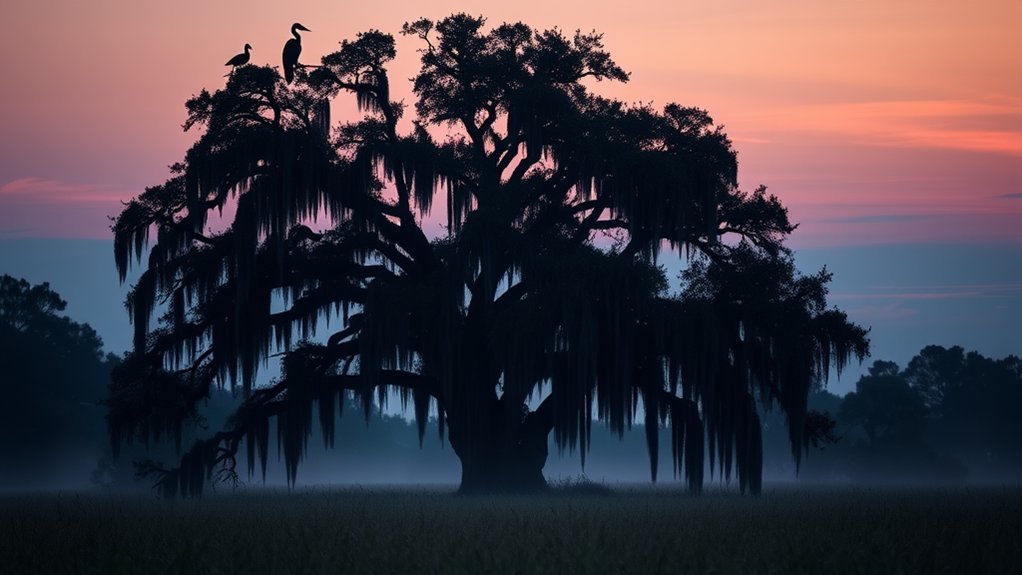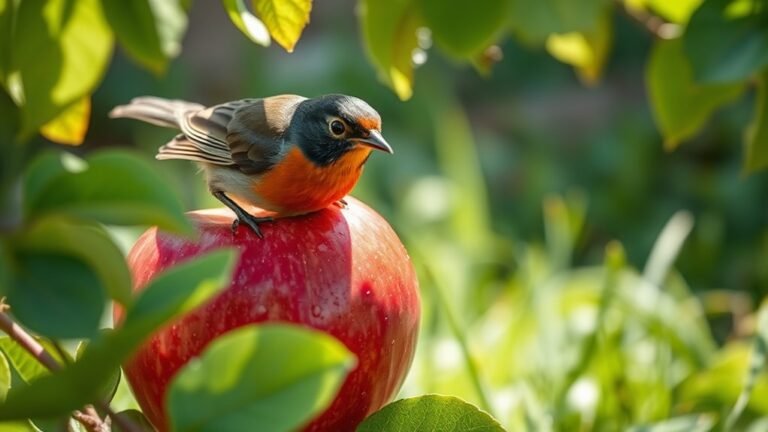Where Do Birds Sleep at Night in North Carolina? Resting Habits Explored
In North Carolina, birds choose specific spots to sleep that reflect their survival needs. They often roost in tall trees or wetlands. These choices help them avoid predators and adapt to their surroundings. Each bird species has developed resting habits suited to the environment and different seasons.
Factors influencing their sleeping spots include safety from danger, food availability, and habitat changes. As urban areas grow and climate changes, these factors may shift, affecting where birds sleep. Understanding these patterns offers valuable insights into bird behavior and conservation.
Key Takeaways
Birds in North Carolina sleep in tree canopies. These trees protect them from predators at night. Marshes and wetlands are also important. These areas have thick plants and water that provide safety.
Some birds find places in cities to rest. They use building ledges and bridges for shelter. Their sleeping locations can change with the seasons. Birds adapt based on the environment.
During migration, birds look for dense forests to rest. These spots help keep them safe from threats. Understanding where birds sleep shows their habits and how they adapt to different conditions.
The Importance of Sleep for Birds
Sleep is crucial for bird health and survival. It affects cognitive functions and physical well-being.
During sleep, birds undergo processes that restore energy and improve learning. These processes help them remember important things, which is vital for their survival. Proper sleep also reduces stress.
A safe resting environment allows birds to lower stress from threats like predators or changes in their surroundings. This supports their mental health and strengthens their immune systems, helping them thrive.
Recognizing the importance of sleep highlights the need for suitable habitats for birds. We must work together to protect these species.
Roosting in Trees: A Common Practice
Birds in North Carolina often roost in trees for safety and protection.
By perching in the tree canopies, they avoid predators like raccoons and owls that hunt at night. Trees offer cover and a variety of branches, allowing birds to find comfortable positions for sleep.
The height of the trees helps reduce risks from ground-based threats. This choice to roost high is a smart move for their safety.
Watching these birds settle in for the night highlights their instinct to find a secure resting place, a common behavior that helps them survive in their environment.
Marshes and Wetlands: A Safe Haven
Roosting in trees helps keep birds safe, but marshes and wetlands are also crucial for their nighttime habits. These ecosystems provide refuge with thick plants and water, shielding birds from predators.
The layers of marsh ecosystems create small habitats where different species can hide and rest. In the soft ground, birds can settle easily, using the wetland's warmth to stay comfortable at night.
Wetland conservation is vital. These habitats support bird populations and promote biodiversity.
Coastal Sleeping Arrangements
Coastal birds have special sleeping habits that help them adapt to their environment. Species like herons and egrets often find safe places to rest on islands or mangroves, where they avoid predators.
They choose their roosting times based on the tides. During high tide, when foraging areas are underwater, they find safety to rest. When the tide goes out, they move to sandbars or tidal flats.
This behavior reduces danger and helps them find food more efficiently. Learning about these habits shows how coastal birds connect with their environment and highlights the beauty of North Carolina's ecosystems.
Urban Environments: Adapting to the Concrete Jungle
As cities grow, birds in North Carolina adapt their sleeping habits. They now use urban structures for roosting, such as building ledges, tree holes, and spaces under bridges.
These locations protect them from weather and predators. The city's bright lights and high noise levels change how birds sleep.
Birds like pigeons and sparrows have found ways to use human-made spaces for rest. This shift helps them survive and connects them with the urban environment.
Their adaptability shows how wildlife can thrive in changing conditions.
Huddling for Warmth: Social Sleeping Behaviors
In cities, birds often display interesting sleeping habits, especially in cold weather. Many birds huddle together in tight groups. This behavior helps them keep warm.
It also promotes social interactions among their species. By gathering closely, birds create a community, which supports their well-being. They exchange calls and stay close, reinforcing friendships.
Sleeping together helps them survive harsh temperatures and strengthens their social ties. This shows how adaptable and resilient bird communities are in urban environments.
Nesting Sites and Their Role at Night
Birds use nesting sites for safety and comfort at night. These nests are made from various materials and provide protection from nocturnal predators.
At dusk, many birds return to their nests not only to rest but also to stay safe. They often mark the areas around their nests to show ownership and deter other species.
This behavior emphasizes their need for security and belonging in their surroundings. Understanding how birds use their nests highlights the importance of these sites for survival in North Carolina's ecosystem.
The Role of Predation in Bird Sleeping Habits
Predation significantly affects bird sleeping habits in North Carolina. Birds choose their sleeping sites and behaviors to avoid predators. They use several strategies:
- They select dense vegetation or tree canopies for protection.
- They choose elevated areas to limit access from ground predators.
- They sleep in flocks to increase group vigilance.
- They may rest during the day in safer locations.
- They hide in spots that provide camouflage.
These behaviors help birds survive by minimizing the risk of predation while they sleep.
Migration: Where Do Birds Sleep Along Their Journey?
Bird migration affects how and where birds sleep, particularly in North Carolina.
During their journeys, birds choose sleep locations based on their migration patterns and the timing of their travels. Many birds prefer to rest in safe spots like dense forests. These areas protect them from predators and bad weather.
While migrating, birds often fly at night and rest during the day. Each bird species has its own sleeping habits and patterns.
Diurnal vs. Nocturnal Birds: Contrasting Habits
Diurnal and nocturnal birds have different habits and adaptations. Diurnal birds are active during the day. They forage, mate, and socialize in daylight. Nocturnal birds, on the other hand, are active at night. They've special habits that help them survive in low light.
Here are the main differences:
- Vision: Diurnal birds see colors clearly. Nocturnal birds have better night vision.
- Feeding: Diurnal hunters find food using sight. Nocturnal hunters rely on other senses.
- Sounds: Diurnal birds make sounds during the day. Nocturnal birds call out at night.
- Resting places: Diurnal birds like open spaces. Nocturnal birds prefer hidden and safe spots.
- Daily cycles: Their activities follow circadian rhythms, which affect sleep.
Understanding these differences helps us appreciate the unique lives of these birds. Each type has special traits that suit their environments, making them fascinating to observe.
Unique Sleeping Strategies of Local Species
Many birds in North Carolina have unique sleeping habits that help them survive. For example, woodpeckers have special toe arrangements that allow them to grip tree trunks tightly while they sleep.
Hummingbirds engage in a behavior called torpor, which slows down their metabolism significantly to save energy overnight.
The Carolina Wren prefers to rest in dense foliage, providing a safe place away from predators.
These sleeping behaviors show how birds adapt to their environment. By observing these habits, we gain a better understanding of how local species manage their rest and thrive in North Carolina's ecosystems.
This knowledge helps us connect more with our bird neighbors.
Seasonal Changes and Their Impact on Resting Spots
Seasonal changes in North Carolina affect where birds choose to rest.
Temperature, food availability, and the presence of predators play key roles in their decisions.
Here are some behaviors you may notice in birds throughout the year:
- In winter, birds look for warmer places to conserve energy.
- In spring, they gather in areas rich in food as they prepare to nest.
- During peak predator activity, birds prefer dense vegetation for protection.
- In fall, many migrate to coastal areas for milder weather.
- As temperatures drop in urban settings, birds may use artificial structures for shelter.
Observing these patterns gives insight into bird behavior and highlights how deeply they connect with their environment.
Conservation Considerations for Avian Habitats
Birds rest in different ways throughout the seasons. This behavior shows their ability to adapt and highlights the need to protect their habitats. Preserving these natural areas is vital for bird populations.
Urbanization and farming lead to the loss of safe resting spots for many birds. You can help by supporting stronger environmental policies that protect these ecosystems.
Wildlife corridors and wetland restoration projects are important initiatives that provide birds with necessary habitats. By joining local conservation groups, you can work with others to improve your environment.
Preserving bird habitats supports resilience in bird populations, boosts biodiversity, and maintains the balance of our ecosystem. Every effort counts, and your involvement makes a difference.
Together, we can ensure that birds have the safe spaces they need throughout the year.
Frequently Asked Questions
Do All Birds Sleep at Night or Have Some Adapted to Stay Awake?
Not all birds sleep at night. Some birds are nocturnal. They stay awake after dark. These species have adapted to their environments to find food and avoid predators at night. Meanwhile, other birds sleep to save energy for their day activities.
How Do Weather Conditions Affect Where Birds Sleep at Night?
Weather extremes and seasonal changes affect where birds sleep at night. During harsh weather, birds use dense foliage or tree cavities for shelter. They adapt their sleeping locations to stay safe and warm against tough conditions.
Do Birds Sleep While Flying During Migration?
Birds do not sleep while flying during migration. Instead, they take short breaks to rest. They use specific migration patterns to recharge. During these breaks, they can orient themselves using stars or the moon. This helps them conserve energy for their long flights.
What Time Do Birds Generally Go to Sleep at Night?
Birds go to sleep soon after sunset. This sleep pattern matches dusk. At night, they find safe places to rest. This helps protect them from predators and saves energy for the next day.
How Can I Help Birds Find Safe Sleeping Spots in My Area?
You can help birds find safe sleeping spots by following these steps.
- Install Birdhouses: Set up birdhouses in your yard. These provide shelter from predators and the weather.
- Preserve Natural Habitats: Keep trees and shrubs in your area. Dense foliage gives birds safe places to rest.
- Plant Native Trees and Shrubs: Choose plants that are native to your region. These offer food and shelter for local bird species.
- Avoid Pesticides: Reduce or eliminate chemical use in your garden. This helps keep birds safe from harmful substances.

Ava is a bird enthusiast and nature lover who has spent countless hours observing and learning about the fascinating world of birds. With a passion for sharing her knowledge and inspiring others to appreciate the beauty of birds, Ava writes about her experiences and insights on avianadmirer.com.







